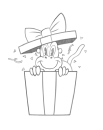Check out the premium course for additional lessons, demos, assignments and critiques!
Moving the Camera and Understanding Form
When I draw a figure or creature, I like to imagine the camera shifting positions. I might place it at a distance and circle around my subject, or bring it in close at a wide angle. As soon as I tilt or move that camera, I notice how forms dramatically change. Ellipses get wider, angles become more extreme, and overlapping shapes become more obvious.
I often start with something simple, a rectangle or cylinder. When I show that shape from different angles, it reveals its three-dimensional volume. Then, I push perspective by scaling the front and back ellipses. If the front ellipse is much bigger than the back, the shape appears to “pop” toward the viewer. Overlapping those ellipses creates an even stronger sense of foreshortening.
Scale Change and Overlap
A key part of foreshortening is scale change, the closer part of a form appears larger, and the far side grows smaller. Overlap also matters. When the shapes partially hide one another, the depth is more convincing. But if I make one section big and fail to adjust everything else in a gradual way, it looks disconnected. I think of it as a progressive swelling toward the viewer, then tapering away in the distance.
When I apply these ideas to an arm, for example, I might run into the fact that real anatomy has specific muscle masses that widen or narrow. In reality, the elbow region can be thicker than the wrist. But when foreshortening, the wrist might end up bigger on the page. To make it work, I’ll slightly widen the elbow and upper forearm area to maintain a believable silhouette. It’s a balancing act between real anatomy and the dramatic perspective.
Applying It to Figures
If I have a figure reaching toward me, I break the limb into cylinders. Then I adjust each cylinder’s size according to its distance from the camera. If I want a more extreme effect, I increase the difference between the nearest shapes and the farthest shapes, and I overlap them more. But that effect can be so strong it doesn’t always look natural, so I find a sweet spot that fits the mood of the sketch.
I often do little thumbnail drawings to see how far I can push the foreshortening before it feels too forced. Even if a super-extreme pose doesn’t look right, the exercise teaches me a lot about perspective and overlapping. It’s especially helpful to experiment on separate pages so I don’t feel locked into one approach.
Wide-Angle Shots and Top-Down Views
When I want an especially dynamic angle, I imagine a wide-angle lens. With a top-down view, I place the camera above the figure, looking down, so the head appears large and the feet are tiny in comparison. Lines on the arms and legs might bend in a curve to hint at that lens distortion. Another approach is the up-shot: I place the camera near the feet, looking upward. The feet will be huge, and the head and shoulders will recede.
I’ll often start with rough construction lines, just enough to anchor my perspective, but I won’t let the technical side bog me down. As soon as I see the big forms placed, I proceed to details like hands, clothing, and facial expressions. If I’m feeling tight or cautious, I’ll stop and begin again. This helps me capture a more fluid, energetic expression.
Practicing and Letting Go
I used to be very methodical about every step, but now I try to let it happen more naturally. That doesn’t mean I ignore fundamentals, I’m always aware of perspective, anatomy, and shape relationships. Yet at some point, I stop planning and let the drawing flow. Some of my best results come from that balance between careful knowledge and a spontaneous approach.
Experimenting is key. I often do multiple sketches of the same pose from different angles, or push the scale changes each time. Along the way, I might discover an arrangement I love, or decide a pose doesn’t work at all. Either way, each attempt teaches me about foreshortening and wide-angle effects. Over time, the practice pays off, and I gain confidence in handling tricky angles.
Influences and Exploration
I’m inspired by artists who freely manipulate perspective, figures like Kim Jung Gi, Moebius, Jack Kirby, and others who just draw to see where the form takes them. For a while, I stuck to pure logic, but I realized I wanted more energy and expression in my sketches. That’s when I started allowing some “jazz” into my drawing, pushing lines, exaggerating shapes, and embracing overlaps. It lets me sketch characters that brim with life, instead of just standing there stiffly.
If you get overwhelmed, remember it’s a natural process to feel unsure when stretching your abilities. I remind myself that each new angle or lens effect is a discovery. The perspective principles don’t go away, but I learn to handle them with a looser grip. I encourage you to try it: move the camera close, tilt it, shrink or enlarge shapes, and see how it transforms your figure drawings.
Have fun exploring these possibilities and don’t be afraid to fail a few times. Each drawing, whether it’s a dwarf, a troll, or a human, pushes your understanding of perspective. With time, you’ll see how meaningful those experiments can be, especially when developing confident, dynamic sketches.
Check out the premium course for additional lessons, demos, assignments and critiques!
















